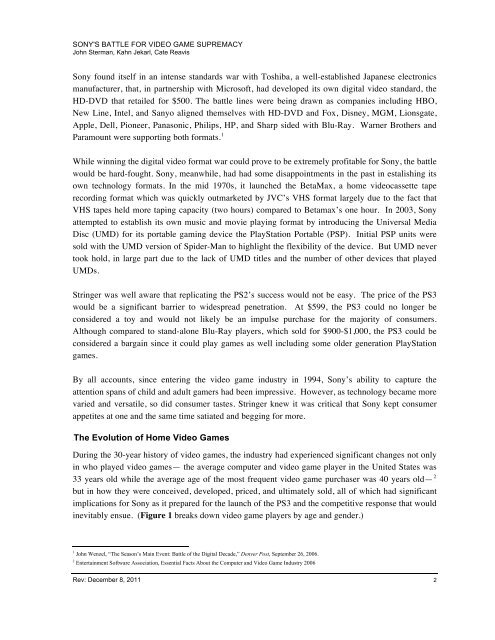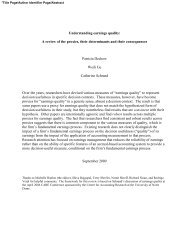Sony's Battle for Video Game Supremacy - MIT Sloan School of ...
Sony's Battle for Video Game Supremacy - MIT Sloan School of ...
Sony's Battle for Video Game Supremacy - MIT Sloan School of ...
You also want an ePaper? Increase the reach of your titles
YUMPU automatically turns print PDFs into web optimized ePapers that Google loves.
SONY'S BATTLE FOR VIDEO GAME SUPREMACY<br />
John Sterman, Kahn Jekarl, Cate Reavis<br />
Sony found itself in an intense standards war with Toshiba, a well-established Japanese electronics<br />
manufacturer, that, in partnership with Micros<strong>of</strong>t, had developed its own digital video standard, the<br />
HD-DVD that retailed <strong>for</strong> $500. The battle lines were being drawn as companies including HBO,<br />
New Line, Intel, and Sanyo aligned themselves with HD-DVD and Fox, Disney, MGM, Lionsgate,<br />
Apple, Dell, Pioneer, Panasonic, Philips, HP, and Sharp sided with Blu-Ray. Warner Brothers and<br />
1<br />
Paramount were supporting both <strong>for</strong>mats.F<br />
While winning the digital video <strong>for</strong>mat war could prove to be extremely pr<strong>of</strong>itable <strong>for</strong> Sony, the battle<br />
would be hard-fought. Sony, meanwhile, had had some disappointments in the past in estalishing its<br />
own technology <strong>for</strong>mats. In the mid 1970s, it launched the BetaMax, a home videocassette tape<br />
recording <strong>for</strong>mat which was quickly outmarketed by JVC’s VHS <strong>for</strong>mat largely due to the fact that<br />
VHS tapes held more taping capacity (two hours) compared to Betamax’s one hour. In 2003, Sony<br />
attempted to establish its own music and movie playing <strong>for</strong>mat by introducing the Universal Media<br />
Disc (UMD) <strong>for</strong> its portable gaming device the PlayStation Portable (PSP). Initial PSP units were<br />
sold with the UMD version <strong>of</strong> Spider-Man to highlight the flexibility <strong>of</strong> the device. But UMD never<br />
took hold, in large part due to the lack <strong>of</strong> UMD titles and the number <strong>of</strong> other devices that played<br />
UMDs.<br />
Stringer was well aware that replicating the PS2’s success would not be easy. The price <strong>of</strong> the PS3<br />
would be a significant barrier to widespread penetration. At $599, the PS3 could no longer be<br />
considered a toy and would not likely be an impulse purchase <strong>for</strong> the majority <strong>of</strong> consumers.<br />
Although compared to stand-alone Blu-Ray players, which sold <strong>for</strong> $900-$1,000, the PS3 could be<br />
considered a bargain since it could play games as well including some older generation PlayStation<br />
games.<br />
By all accounts, since entering the video game industry in 1994, Sony’s ability to capture the<br />
attention spans <strong>of</strong> child and adult gamers had been impressive. However, as technology became more<br />
varied and versatile, so did consumer tastes. Stringer knew it was critical that Sony kept consumer<br />
appetites at one and the same time satiated and begging <strong>for</strong> more.<br />
0BThe Evolution <strong>of</strong> Home <strong>Video</strong> <strong>Game</strong>s<br />
During the 30-year history <strong>of</strong> video games, the industry had experienced significant changes not only<br />
in who played video games— the average computer and video game player in the United States was<br />
2<br />
33 years old while the average age <strong>of</strong> the most frequent video game purchaser was 40 years old—F F<br />
but in how they were conceived, developed, priced, and ultimately sold, all <strong>of</strong> which had significant<br />
implications <strong>for</strong> Sony as it prepared <strong>for</strong> the launch <strong>of</strong> the PS3 and the competitive response that would<br />
inevitably ensue. (Figure 1 breaks down video game players by age and gender.)<br />
1 John Wenzel, “The Season’s Main Event: <strong>Battle</strong> <strong>of</strong> the Digital Decade,” Denver Post, September 26, 2006.<br />
2 Entertainment S<strong>of</strong>tware Association, Essential Facts About the Computer and <strong>Video</strong> <strong>Game</strong> Industry 2006<br />
Rev: December 8, 2011 2
















